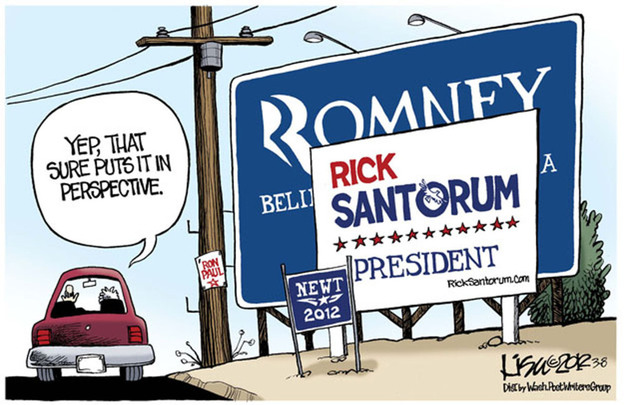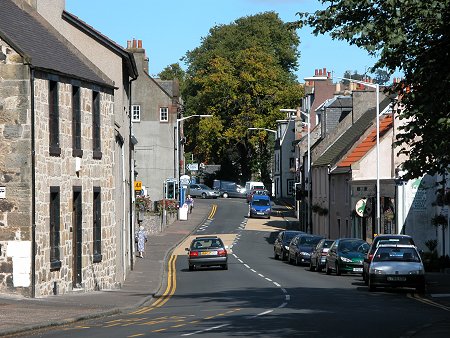American mass media is under constant bombardment for its "liberal agenda". But how much of it is real, and how much is just smoke and mirrors? Fraser Doig investigates
The Republican Party finally has its
‘presumed’ presidential candidate. And Mitt Romney, who’s spent almost an
entire year on the road promoting his campaign, only has the voters to thank.
But wait, does he? With public outcry in the States over alleged media bias
during the 2012 election campaign, did he win fairly? Or did he get by with a
little help from his ‘friends’?
Governor
Romney’s roots are in venture capitalism. His private equity firm Bain Capital
has made him $250 million. It also claims co-ownership over Clear Channel, the
largest radio station owner in the United States. It plays host to a number of
politically conservative radio programmes such as the Rush Limbaugh Show, the
Glenn Beck Program, the Sean Hannity Show, and Fox News Radio. His business
also shares ownership of MSNBC’s parent company The Weather Channel. With this
kind of power in his back pocket, you could be forgiven if you think that the
odds are slightly stacked in his favour.
The notion that the press has abandoned its
duty to act as ‘the fourth estate’ – a medium in which the general public is
informed of the facts from a fair and balanced perspective – has tainted the
journalistic profession since its conception. Historians have found that as far
back as the 18th Century, publishers often served the interests of powerful social groups, and throughout the ages, the call for an unbiased media has
been growing in intensity, particularly with our American neighbours.
The First Amendment to the United States
Constitution proclaims that all Americans, including the press have the right
to freedom of speech. This is their constitutional right and, thus, cannot be
taken away by any law made by Congress. Now of course, this right is imperative
to the principles of democracy. In the words of the late, great Walter Cronkite,
“A democracy ceases to be a democracy if its citizens do not participate in its
governance.” But be warned – the act of feverishly flapping your gums with
gung-ho enthusiasm can be a dangerous exploit.
To
counter-balance the significant liberties the Constitution endows upon a
potentially partisan media, the Society of Professional Journalists was
established in 1909 by scholars from DePauw University, Indiana, with the sole intention
to “promote and defend the First Amendment, encourage high standards and
ethical behavior in the practice of journalism, and promote and support
diversity in journalism”. Their ‘Code of Ethics’ highlights virtues such as
supporting the open exchange of views, even if you don’t agree with them,
distinguishing between advocacy and journalism, and never allowing deliberate
distortion of the truth. Although these are only voluntary guidelines, they are
embraced by thousands of journalists throughout the United States, and there is
expectancy for all journalists to abide by these ‘unofficial’ rules. But are
they?
Not
according to Bruce Ramsey of The Seattle Times, who believes that a biased
media is inescapable.
“The
profession as a whole can’t avoid it. Journalists have political opinions by
the time they are at university, before they become journalists. The
much-spoken-of liberal bias in the media derives from the longtime fact that
most journalists in the mainstream media have political opinions that are
somewhat to the left of the general public.”
A
social scientific study into the ideological commitments of 238 journalists from
America’s most influential news organisations concurs with this. The study
titled ‘The Media Elite’, found that top journalists from ABC, CBS, The New
York Times, Washington Post and other significant news outlets were
predominantly Democrats, with 54 per cent of them describing their political
leanings as left of center. 29 per cent professed that they were “middle of the
road” and only 17 per cent claimed they were right of center. It concluded that
coverage of controversial topics such as abortion and gay rights reflected the
attitudes of the journalist reporting it, and the presence of political
liberals in the newsroom pushed coverage in a liberal direction.
This
“liberal agenda” that is so often used as ammunition by Republicans was a
burning issue during the 2008 presidential election, when Republican candidate
Senator John McCain chose Governor of Alaska Sarah Palin as his
vice-presidential running mate. Her frequent on-air gaffes and traditionally
conservative views served as ideal fodder for the so-called liberal media,
which routinely chose to publish anti-Palin stories over positive ones. After
her personal life was unearthed, the writing was on the wall. They slated her
to such an extent that the original story of her becoming McCain’s running mate
was lost in the throng of “Palinisms”, and the Republican Party were left with
egg all over their face.
Was
this fair? Depends on whom you ask. Republicans were furious with the media for
their vilification of Sarah Palin, claiming that it was unjustified and
inappropriate. Many liberals didn’t even try to deny it, with leading CNN news
anchor Kathleen Parker admitting she “led” the character assassination of
Palin, declaring that she was “out of her league”. Not quite “supporting the
open exchange of views” now, is it?
 |
| photo: NPR |
One
of the most powerful weapons in a journalist’s arsenal is the language they
use. Bev Harris, founder of Black Box Voting – a nonprofit watchdog group
dedicated to promoting transparency in American elections, states that primary
elections in the States, specifically those held in New Hampshire, Iowa and
South Carolina, are held for the sole purpose of “culling down the field”.
“If
a candidate “exceeds expectations” built by TV punditry, three things happen:
TV pundits start the drumbeat, building public expectations about “inevitability”
of the candidate who did “better than expected”. Donor money reroutes itself,
pouring dollars into the newly inevitable candidate. Media then reports on the
candidate’s prowess in fund raising, citing this newly found skill as reason to
believe the candidate is even more inevitable.”
In
the event of a candidate performing poorly in the primaries, Harris paints a
very different picture of the media.
“If
they receive fewer votes than “expected”, the media speculates repetitively on
when they will drop out, funds dry up, the media cites weaker donations as
evidence that the candidate cannot win, and the party begins pushing the
candidate to get out of the way.”
This
type of partisan reporting has been accepted as a necessity to serve the purpose
of weeding out the less serious candidates and leaving a prime crop of “front
runners”. But when leading candidates are being ostracised by the media, that’s
when it starts to get messy.
Texas
Congressman Ron Paul kick-started his presidential campaign in early 2011 with
a string of landslide victories that went almost totally unreported by the
media. Later on at the Ames straw poll, some channels flat out ignored his
impressive second place result, and he was declared a “loser” by The Washington
Times, which then went on to say Rick Santorum, with 3,014 votes less than
Paul, was a “winner”. In fact, on the rare
occasion Dr. Paul was brought up by political commentators, it was usually to
condescend and ridicule him. For an ideologically consistent 12-term
congressman, many were pondering the question – why?
The
fact that Dr. Paul wasn’t afraid to voice his criticism of the Federal Reserve
and America’s foreign wars placed him firmly outside of the typical
Republican’s firmly held beliefs. He was considered as radical and unpatriotic
and this led to a stonewalling of Ron Paul coverage. His supporters were
emphatic with rage and screamed “CONSPIRACY!” at the top of their lungs, but
were only met with cold, complacent denial from the media. The general
consensus from the majority of news stations was that the accusations of bias
were blown way out of proportion, and lack of coverage was purely down to the
fact that “crazy uncle Ron” was unelectable.
Not
everybody buys into the “bias media” dogma quite like Ron Paul supporters do
though; Elizabeth Skewes, Colorado University lecturer and author of ‘Message
Control: How News is Made on the Presidential Campaign Trail’ finds that
there’s a lot less to worry about than people make out.
“In
elite newspapers and stations like CNN, ABC, NBC and CBS the charge of bias is
largely faulty. These organisations, I believe, try to adhere to a standard of
balance and neutrality.”
Regardless
of the ethical standards of journalism, there’s no denying that people love a
good scrap. Ken Silverstein - Washington editor of Harper’s Magazine and
self-professed “gad-fly” of the newspaper industry - is adamant that the true
spirit of journalism cannot live without the presence of passionate individuals
who relay their opinions as fervently as possible.
“”Balanced”
coverage that plagues American journalism leads to utterly spineless reporting
with no edge. When it comes time to write, we are expected to turn our brains
off and repeat the spin from both sides. God forbid we should attempt to fairly
assess what we see with our own eyes.”
Looking
objectively, the media bias in the United States is undeniably rife, and spells
danger for the forthcoming presidential election. With the country in economic
turmoil, and the possibility of a new man at the helm, it is of vital
importance that the public is made aware of the facts without the added spin,
and there is freedom to share opinions without the fear of incurring the wrath
of the media elites. Alas, this is an unlikely scenario. The onus is on the
American people alone to educate themselves so that they can make an
independent decision, before the media makes it for them.
Is
it as bad in the UK?
The ubiquity of media bias in the United
States is largely apparent, but what about us?
 It is commonly known that the British press
has ties with political figures who use newspapers to generate public appeal.
The press shows loyalty by printing favourable stories about their preferred
party, sometimes obtained through the party’s “spin doctor”, which has a
significant influence on the public’s perception of them. On the other hand, it
is less familiar in televised news. A survey conducted by themediablog.co.uk asked
members of the public where they thought leading British news channel’s
allegiances lie. It found out that nearly two-thirds of respondents thought Sky News
displays a clear pro-Conservative bias, with no hint of support for Labour. Conservative came up trumps with ITV News too,
with 29 per cent of respondents believing they show a pro-Conservative bias.
Channel 4 is believed to be the most neutral, with 48 per cent of respondents
saying the channel displays no clear bias and 27 per cent saying they are
unsure. The BBC is also perceived to be largely unbiased, with 44 per cent of
respondents seeing no overall bias.
It is commonly known that the British press
has ties with political figures who use newspapers to generate public appeal.
The press shows loyalty by printing favourable stories about their preferred
party, sometimes obtained through the party’s “spin doctor”, which has a
significant influence on the public’s perception of them. On the other hand, it
is less familiar in televised news. A survey conducted by themediablog.co.uk asked
members of the public where they thought leading British news channel’s
allegiances lie. It found out that nearly two-thirds of respondents thought Sky News
displays a clear pro-Conservative bias, with no hint of support for Labour. Conservative came up trumps with ITV News too,
with 29 per cent of respondents believing they show a pro-Conservative bias.
Channel 4 is believed to be the most neutral, with 48 per cent of respondents
saying the channel displays no clear bias and 27 per cent saying they are
unsure. The BBC is also perceived to be largely unbiased, with 44 per cent of
respondents seeing no overall bias.


